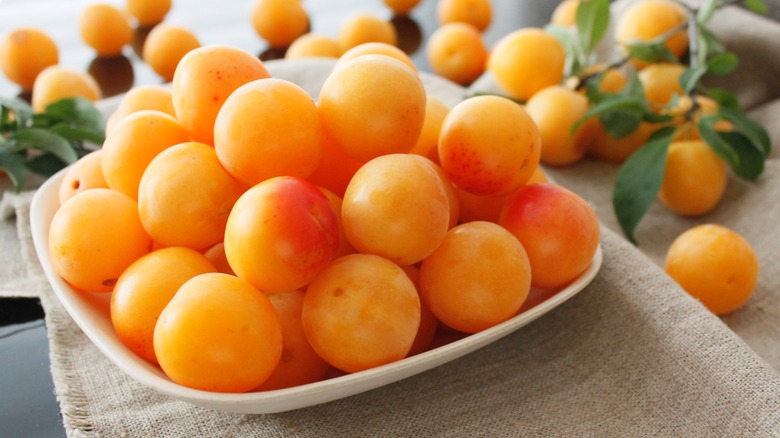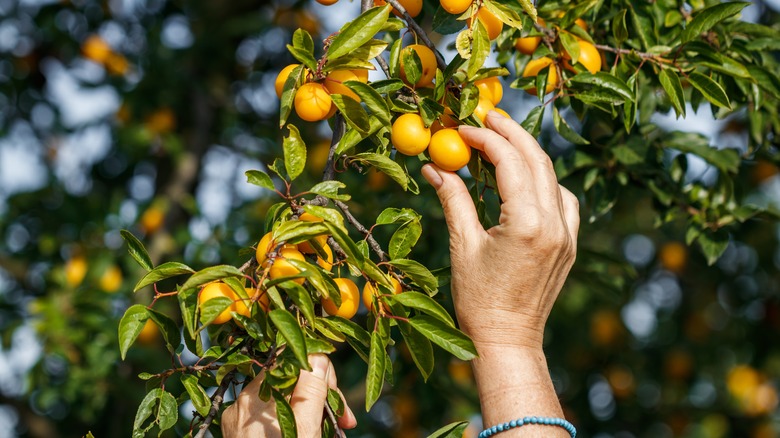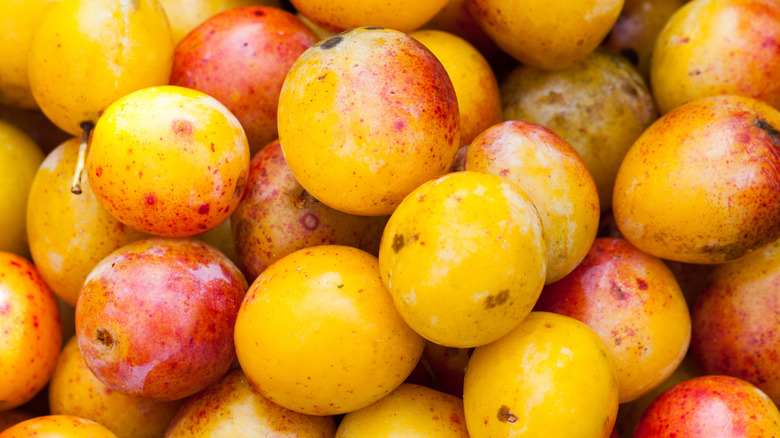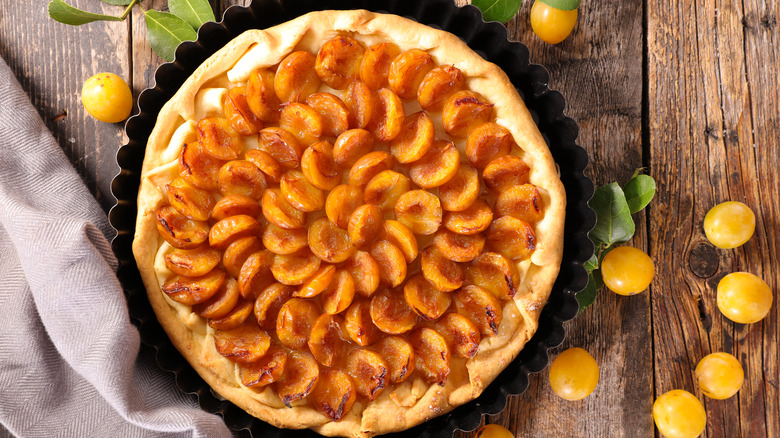The Sweet French Plum That's Almost Impossible To Find In The US
Eating fruit never goes out of style. Full of vitamins, and fiber, low in calories, and generous in natural sugars, fruit is a welcome addition to breakfast, lunchboxes, sometimes dinner, and definitely desserts. According to Statista, In 2021 bananas, with strawberries, grapes, apples, and watermelon were America's top five most-eaten fruits. While oranges, peaches, and even avocados made the top ten list, the unassuming plum did not. Surprising, really, considering that plums are pretty readily available all year long, and the fact that there are so many delicious varietals to choose from.
Plums are a stone fruit containing a hard pit in the middle. The skin is edible and on the tart side but the flesh is usually very sweet and soft when ripe. You've probably seen and eaten Elephant Heart plums, even if they weren't labeled as such, because, according to Masterclass, it is one of the most common types found in markets. It is a Japanese varietal, as are Black Ruby plums, Black Beauties, and Black Ambers. European plums include Greengage, Moyers, and Damsons. There is even a uniquely native plum type called the American plum that hails from Wisconsin. They all vary subtly in flavor, juiciness, and pit size. In general, people have access to these whether found at the grocery store, farmers' markets or online. But there is one coveted type of plum from France that is so elusive, you might have to book a flight there to get your hands on one.
Meet Mirabelle
According to Regions of France, the late French media personality, Jean Pierre Coffe, once stated, "Happiness exists. I've met it. It weighs 14.3 grams and it comes from Lorraine." He was referring to Mirabelle plums, small, golden-colored plums grown in the Lorraine region of France. Its name comes from the Latin "mirabilis" which means "of wondrous beauty" and it is not difficult to figure out why with the fruit's yellow-peach skin that stands out from the tree limbs they are grown on, via Minnetonka Orchards.
There are actually two types of Lorraine Mirabelles, per the blog French Moments; the Mirabelle de Nancy has golden yellow skin that is freckled with red dots. It is about 1.1 inches in diameter. Mirabelle de Metz is less than an inch in diameter and has some red in its coloring. Although substantially smaller than other plum varietals, they are amongst the sweetest in the world.
Found only in France
The French are very protective of their prized creations and crops and so, as real champagne can only come from the Champagne region of the country, Mirabelles can only be imported from Lorraine. This is nothing new in the world of international foods. For example, legit balsamic vinegar must come from Modena Italy, and real Parmesan cheese only comes from the Reggiano region of Italy, and both are fairly simple to find in the United States. However, while France is certainly free to export their prized plums, Mirabelles don't travel well. Once ripe, Mirabelle plums become very soft and, therefore, easily damaged during the transport process, per Masterclass.
The harvest season of these elusive fruits is also fairly short. Just like Americans clamor for heirloom tomatoes and sweet corn in the late summer months, the French clamor for Mirabelles from mid-August through September (via French Moments). Every August the town of Metz, France hosts the Mirabelle Plum Festival celebrating the local treat, which about 80,000 visitors attend, no doubt putting a large dent in the harvest.
A flavor like nothing else
Minnetonka Orchards describes the flavor of Mirabelle plums as very sweet, yet smooth and rich, much like the California-grown Santa Rosa varietal. Some critics even pick up flavors of banana or pineapple. The trees usually produce a high yield of fruit and while eating them right off the tree is always a good idea, chances are there will be more than a few left over. In Lorraine, Mirabelles are often baked into desserts like tarts and galettes. They can be frozen or dried in order to be preserved or made into dreamy jam.
You may be thinking that the closest you'll ever get to Mirabelles is ordering a jar of preserves online, which is just fine, however, if you're a go-getter absolutely determined to see what the hub-bub is all about, you can grow your own, which is perfectly legal. Mirabelle seeds are available for purchase in the US, but growing a tree will take some patience. According to French Moments, a Mirabelle tree will bear fruit after 8 years, so don't expect instant gratification, but if cared for, the tree can bear fruit for decades. Remember, you can't export or sell this fruit once it's ripe, but you will have access to something most people never will.



